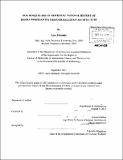| dc.contributor.advisor | Nasser Rabbat. | en_US |
| dc.contributor.author | Aksamija, Azra, 1976- | en_US |
| dc.contributor.other | Massachusetts Institute of Technology. Dept. of Architecture. | en_US |
| dc.date.accessioned | 2012-01-12T19:25:50Z | |
| dc.date.available | 2012-01-12T19:25:50Z | |
| dc.date.copyright | 2011 | en_US |
| dc.date.issued | 2011 | en_US |
| dc.identifier.uri | http://hdl.handle.net/1721.1/68415 | |
| dc.description | Thesis (Ph. D.)--Massachusetts Institute of Technology, Dept. of Architecture, 2011. | en_US |
| dc.description | Cataloged from PDF version of thesis. | en_US |
| dc.description | Includes bibliographical references (p. 485-531). | en_US |
| dc.description | This dissertation examines how Bosnian Muslims construct their identity through the lens of rebuilt or newly built mosques following the systematic destruction of religious architecture during the 1992-1995 War. The stylistic diversity of contemporary mosques in the region, I argue, reflects competing visions of how contemporary Bosnia should deal with its own history of coexistence and war. By examining different identity formation processes on three scales (the building process, the regional, and the global scale), the dissertation argues that, aside from its religious functions, the contemporary mosque has become the primary locus where the emerging Bosniak nation can visually and symbolically shape and express its visions of itself. I begin by outlining how the cultural and political history of Bosnian Muslims has been "written" and "rewritten" through religious architecture since the fifteenth century. I then investigate how during the war of the 1990s the nationalist extremists instrumentalized religious architecture to facilitate the realization of their expansionist projects. While all ethno-national groups in Bosnia experienced significant war losses, Bosnian Muslims suffered the greatest human and architectural casualties. I argue that the extent and the genocidal nature of war violence against them has transformed the meaning of the mosque from that of a place of worship and of a signifier of religious-ethnic identity to that of the ethnic body of the Bosniak nation. The notion that the mosque stands in for the human body was internalized by Bosnian Muslims in the form of two novel and programmatically delineated mosque genres defined here as the Inat Mosque and the Memorial Mosque. The first results from identity construction in response to the national myths and territorial claims of the Serbs and Croats, while the second represents identity creation that is linked to the community's own internal processes of commemoration. These regional negotiations of identity are challenged by two competing global imperial ideologies introduced to Bosnia by the Saudi and Turkish donors and manifest in monumental mosques they finance. As local builders compete with these supra-national Islamic networks, contemporary mosque architecture in Bosnia has become a site of negotiation and frictions between global and local interests. Throughout, the analysis highlights the significance of ethnic symbols, long-term cultural factors, and global cultural flows in the creation of contemporary nations. | en_US |
| dc.description.statementofresponsibility | by Azra Aks̆amija. | en_US |
| dc.format.extent | 531 p. | en_US |
| dc.language.iso | eng | en_US |
| dc.publisher | Massachusetts Institute of Technology | en_US |
| dc.rights | M.I.T. theses are protected by
copyright. They may be viewed from this source for any purpose, but
reproduction or distribution in any format is prohibited without written
permission. See provided URL for inquiries about permission. | en_US |
| dc.rights.uri | http://dspace.mit.edu/handle/1721.1/7582 | en_US |
| dc.subject | Architecture. | en_US |
| dc.title | Our mosques are US : rewriting national history of Bosnia-Herzegovina through religious architecture | en_US |
| dc.type | Thesis | en_US |
| dc.description.degree | Ph.D. | en_US |
| dc.contributor.department | Massachusetts Institute of Technology. Department of Architecture | |
| dc.identifier.oclc | 768478450 | en_US |
